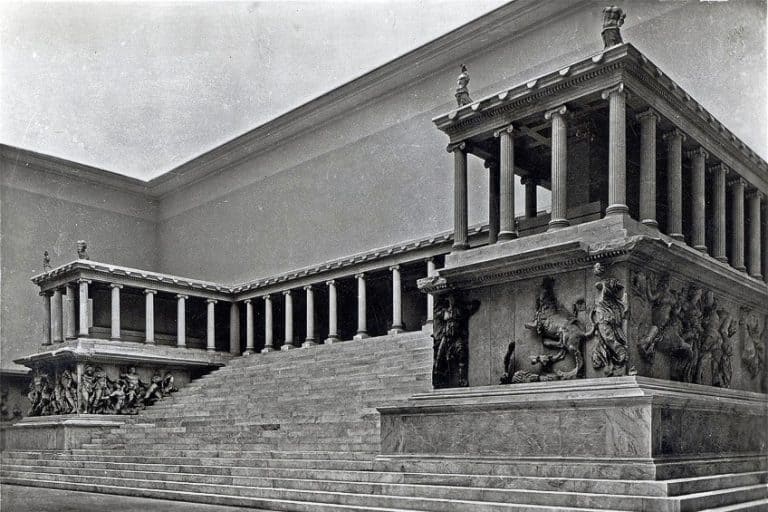Eiffel Tower in Paris – Why Was the Eiffel Tower Built?
Who built the Eiffel Tower in Paris? Why was the Eiffel Tower built, to begin with? These are a few common questions that arise when people first see this striking edifice while exploring the Eiffel Tower’s history. This article will investigate the Eiffel Tower facts, such as the Eiffel Tower’s height, and answer all your questions, such as, “how many people died building the Eiffel Tower?”, and, “how many floors is the Eiffel Tower?”.
Exploring the Eiffel Tower’s History
| Architect | Charles Léon Stephen Sauvestre (1847 – 1919) |
| Date of Completion | 1889 |
| Materials | Wrought iron |
| Function | World Fair Monument in 1889 |
| Location | Champ de Mars in Paris, France |
First off, why was the Eiffel Tower built? A large competition was announced in the Journal Officiel for the 1889 fair which commemorated the French Revolution’s 100th anniversary. The proposal to construct a 300-meter-tall tower was devised as part of the World’s Fair preparations. The challenge was to examine the potential of creating a massive tower on the Champ-de-Mars in Paris, France. The design created by Gustave Eiffel, Stephen Sauvestre, Maurice Koechlin, and Emile Nouguier was chosen from among 107 entries. In June 1884, the two principal engineers in Eiffel’s business, Maurice Koechlin and Emile Nouguier had already developed an idea for a very high structure.

It was to be built in the shape of a giant pylon, comprising four columns of latticework girders divided at the base and joining at the top, and connected by further metal girders at periodic intervals. The Eiffel Tower in Paris would be a daring expansion of this concept up to a height of 300 meters. On the 18th of September, 1884, Eiffel registered a patent “for a new arrangement permitting the building of pylons and metal supports capable of surpassing a height of 300 meters”.
The First Proposed Version of the Eiffel Tower in Paris
Sauvestre suggested masonry pedestals to adorn the legs, massive arches to connect the columns and the first floor, vast glass-walled rooms on each tier, a bulb-shaped structure for the top, and a variety of additional aesthetic embellishments to beautify the entire tower. The proposal was ultimately modified, but key components, such as the huge arches at the base, were maintained, giving it its distinctive appearance. The uprights’ curvature is precisely designed to provide the most effective wind resistance achievable.
There were numerous individuals opposed to the idea at the time, and they wrote a letter, arguing that it was a risk to the romantic spirit of Paris. Since it stood in stark contrast to the elegance and refined beauty of the city, a massive and unsightly tower constructed from iron in the center of Paris was considered to be extremely undesirable.
Construction of the Eiffel Tower in Paris
The construction of the supports started on the 1st of July, 1887, and was finished approximately two years later. Each of the 18,000 components required to build the tower was precisely planned and calibrated, traced out to a 1/10th of a millimeter accuracy, and then fitted together to make new sections roughly five meters in length. The 150 to 300 employees on site erecting this massive undertaking were overseen by a crew of constructors who had previously worked on large metal viaduct projects. Rivets hold all of the tower’s metal sections together, a well-refined form of assembly at the time the Eiffel Tower in Paris was built.
In the factory, the parts were first fastened together with bolts before they were subsequently substituted with thermally linked rivets that shrank during cooling, resulting in extremely tight fittings. Each rivet required four men to construct: somebody to heat it up, somebody else to hold it in place, a third person to form the head, and a final person to pound it with a sledgehammer.
The uprights are supported by concrete foundations set a few meters beneath ground level over a bed of compressed gravel. The engineers used air pumps to pressurize watertight metal caissons on the structure’s Seine side so they could work below the waterline. The tower was built with timber scaffolding and steam cranes set on the tower.
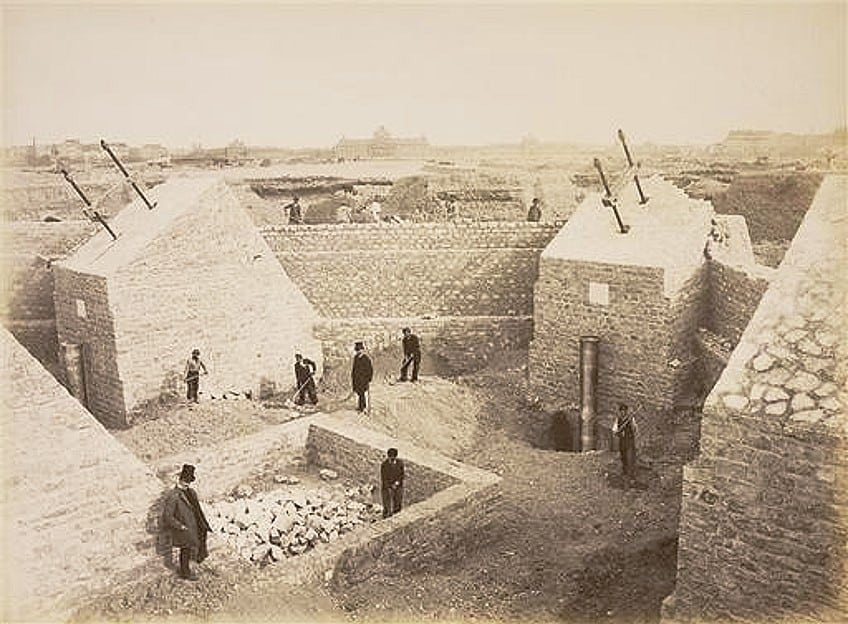
The first tier was constructed with the help of 12 temporary timber scaffolding structures that each measured 30 meters in height, as well as four bigger scaffolds that were each 40 meters in height. Hydraulic jacks and “sandboxes”, enabled the metal girders to be set to one-millimeter precision, which was replaced after usage by permanent wedges. The linking of the principal girders up to the first story was finished on the 7th of December, 1887. The sections were hoisted up by steam cranes, which ascended the tower as they went, utilizing the runners that would be employed for the Tower’s lifts. It only took five months to construct the foundations and 21 months to complete the tower’s metal parts. Given the unadvanced techniques available at the time, this could be regarded as record speed.
All chroniclers of the time agree that the tower’s construction was a marvel of engineering perfection. Initial work on the structure commenced in January 1887 and was completed on the 31st of March, 1889. Eiffel earned his Legion of Honour award on the tiny platform at the summit.
From Temporary Edifice to Permanent Symbol
When work on the project started, it was decided that the license rights of the tower should only last for two decades before it was destroyed. During the fair, however, two million people toured the Eiffel Tower. The tower gained popularity as a representation of French industrial prowess after experiencing phenomenal success. During the 1900 Universal Exposition, the Tower was similarly successful with visitors. Gustave Eiffel put a lot of time and effort into proving the tower’s usefulness to science in order to prevent its destruction.
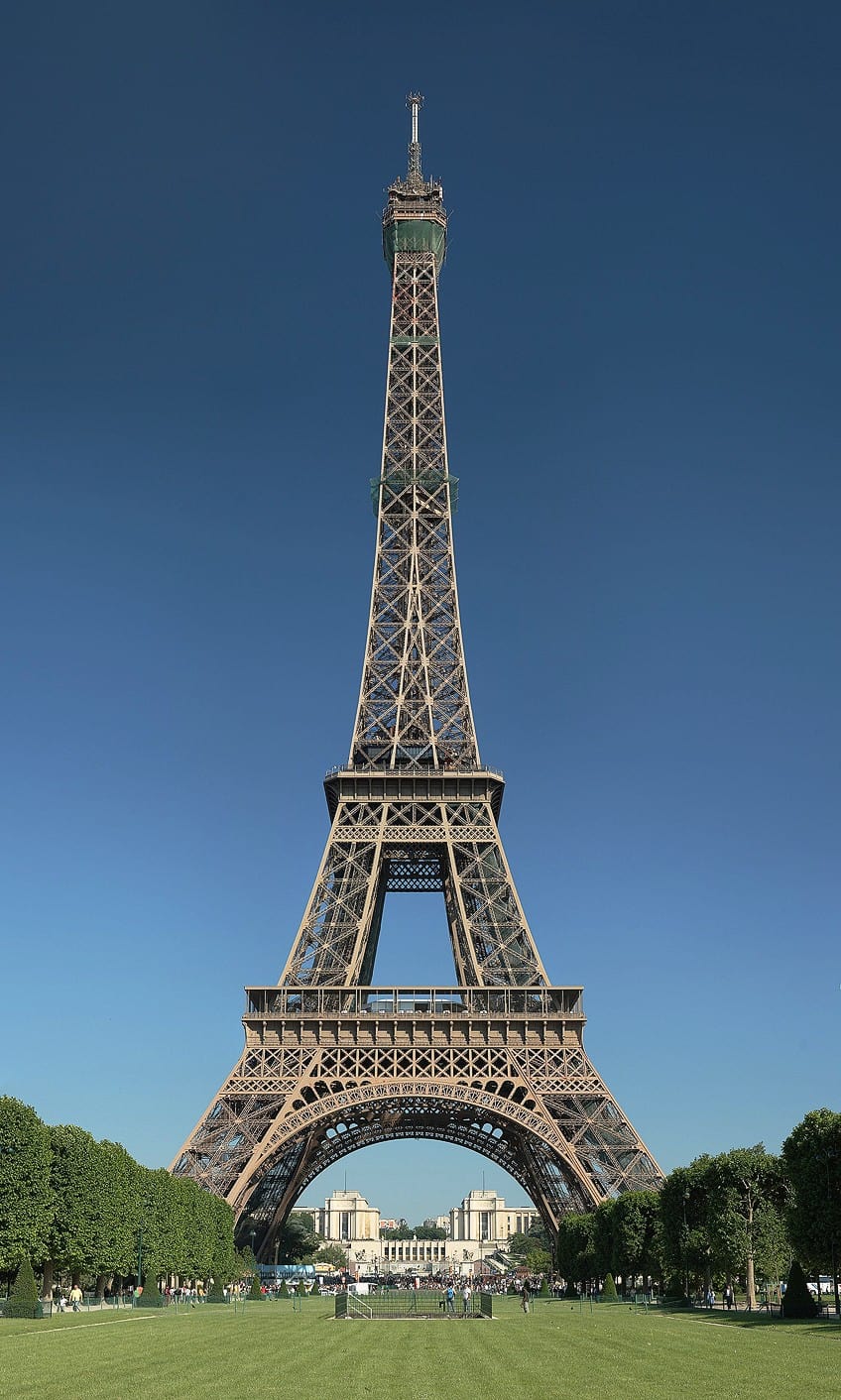
Scientific investigations in physiology and astronomy were carried out, but what ultimately saved the tower was its employment as a radio antenna tower, first for military communications and subsequently for continuous, radiotelegraphy communications; in reality, the Eiffel Tower in Paris served numerous purposes throughout the First World War. Because of its success, numerous nations throughout the world have built replicas of the Tower that are nearly identical to the original.
Design of the Eiffel Tower in Paris
The tower is painted in three colors, with the top being the brightest and the bottom being the darkest, to match the color of the Parisian sky. The tower is now being painted gold in honor of the approaching 2024 Summer Olympics in Paris, in what is intended to be a temporary alteration. The four ornate grill-work arches introduced in Sauvestre’s designs to make the tower seem more solid and to provide a more dramatic entry to the exposition are the sole non-structural components. A popular movie cliché often portrayed in cinema is that the vista from a Parisian window typically features the Eiffel Tower. However, In reality, because zoning rules limit most structures in Paris to seven floors, only a few tall structures actually have a clear view of the structure.
The Eiffel Tower’s wrought iron weighs 7,300 tonnes, and the inclusion of stores, lifts, and antennas has increased the overall weight to almost 10,100 tonnes. When the tower was initially built, many were surprised by its daring design. Eiffel came under fire for attempting to construct something aesthetically pleasing while ignoring standard engineering principles.
However, Eiffel and his designers, who had experience developing bridges, understood the implications of wind forces and knew that if they were going to construct the tallest structure in the world, they had to be confident it could withstand them properly. Instead of a mathematical formula, he employed graphical methods to calculate the stability of the tower and practical knowledge to account for the impacts of wind. A close analysis of the tower reveals that it is essentially exponential in form. To guarantee optimum resistance to wind forces, all components of the tower were overdesigned. Even the top of the latticework was going to be without gaps. Engineers have proposed many mathematical theories to explain the design’s success in the decades since it was erected.
Accommodation and Passenger Lifts in the Eiffel Tower
An Anglo-American Bar and three restaurants (Russian, French, and Flemish) were originally located on the first floor. When the exhibition was over, the Flemish restaurant was converted into a theater that could host 250 guests. An open-to-the-public modest apartment allocated for Gustave Eiffel to host guests, complete with period furnishings and lifelike figurines of Eiffel and some of his prominent guests, was located at the top of the building along with labs for various kinds of research projects. In order to host the competition winners at the football tournament, UEFA Euro 2016 in Paris that June, an apartment was built on the first story in May 2016. The property features views of famous Parisian monuments, a kitchen, two bedrooms, and a living area.
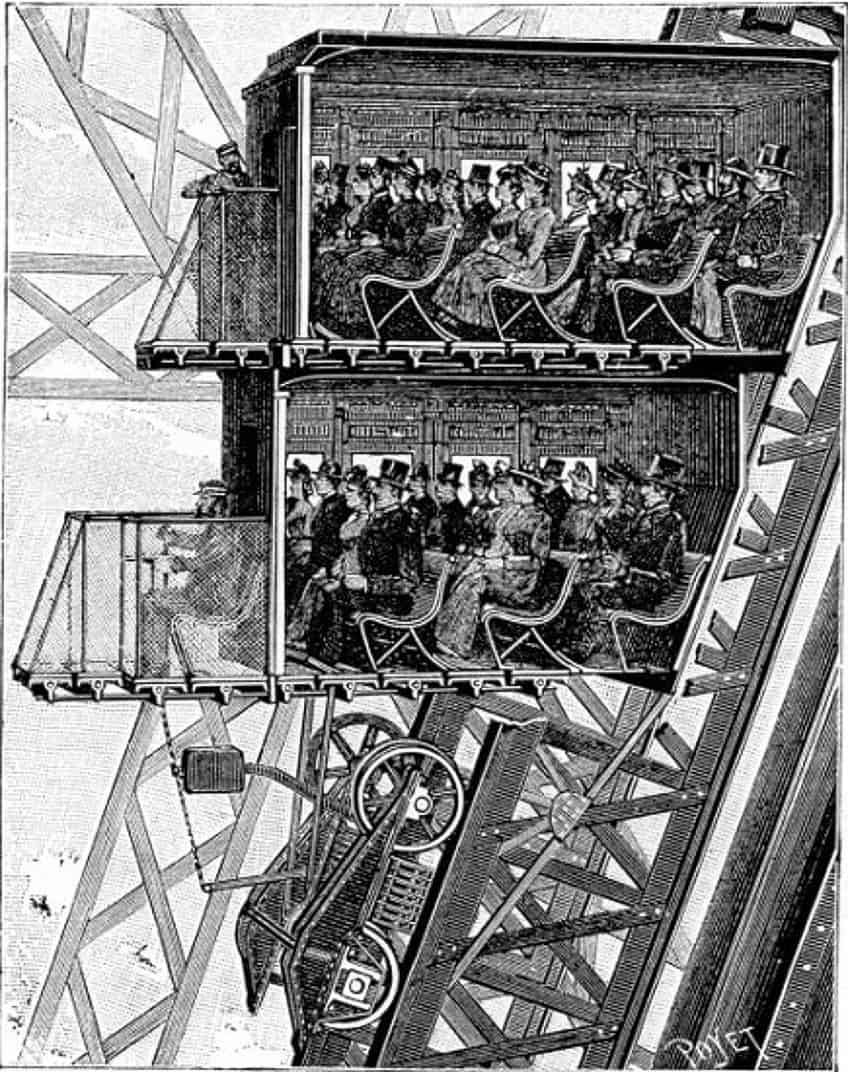
Throughout the tower’s existence, the elevator layout has undergone several changes. Each lift takes an average of nearly nine minutes to execute the round trip, with each level requiring an average of one minute, taking into account the flexibility of the cables and the time needed to synchronize the carriages with the landings. The original hydraulic system is on exhibit at the base of the eastern and western legs in a tiny museum. Because the mechanism needs regular lubrication and repair, public access is frequently limited. As guests depart the elevator, they can view the north tower’s rope system.
The Eiffel Tower and Tourism
The Eiffel Tower in Paris is situated at the crossing point of the Pont d’Iéna and Quai Branly. Since its completion in 1889, it has been visited by over 300 million visitors. The Eiffel Tower in Paris has been recorded as the most frequently visited paid monument. Every day, around 25,000 people visit the tower, culminating in enormous lines. There was also a restaurant near the tower’s highest point from 1937 to 1981. Engineers concluded it was excessively heavy and caused the tower to slump, thus it was removed for structural reasons.
This restaurant was purchased by an American restaurateur and relocated to New York, then to New Orleans. It was reconstructed as a restaurant and eventually an event venue on the outskirts of New Orleans’ Garden District.
Replicas of the Eiffel Tower
The Eiffel Tower, being among the world’s most easily recognized sights, has inspired the construction of several replicas and comparable towers. Blackpool Tower in England is an early instance. Sir John Bickerstaffe, the mayor of Blackpool, was so fascinated with the Eiffel Tower during the 1889 exposition that he requested a comparable structure to be erected in his town. It was built in 1894 and is 158 meters tall. Tokyo Tower, erected in 1958 as a communications tower, was similarly influenced by the Eiffel Tower. In the United States, there are several scale models of the tower, such as a version at the Paris Las Vegas in Nevada that is half the size of the actual structure in France.

The Conman Who Sold the Eiffel Tower in Paris
Victor Lustig was a highly adept con artist from Austria who embarked on a criminal lifestyle of scams that led him across the United States and Europe in the early 20th century. Lustig visited France in 1925. While in Paris, he came across a newspaper story on the difficulties in sustaining the upkeep of the Eiffel Tower, which inspired him to create a new scam. The monument had started to deteriorate at the time, and the government was finding it increasingly costly to preserve and repaint it. A fleeting remark in the newspaper stated that general public opinion on the monument will shift toward requests for its removal, which was crucial in convincing Lustig that utilizing it as part of his next scam would be profitable.
Lustig began planning the fraud after studying what he needed to do with the information he had learned from the article, which included employing a forger to create fake official stationery for him. When he was ready, Lustig called a select group of scrap metal merchants to a private meeting at a fancy hotel, where he introduced himself as the Deputy Director-General of the Ministry of Posts.
During the meeting, he persuaded the group that the maintenance of the Eiffel Tower was becoming too expensive and that the government hoped to sell it for scrap, but that since such a sale would be contentious and likely spark public outrage, nothing was to be publicly revealed until all the details were worked out. Lustig said that he was in charge of picking the dealer who would claim control of the building, adding that the group had been picked carefully because of their credentials as “honest business people”. His speech provided true insight into the monument’s role in the city, as well as how it did not blend in with the city’s other major monuments, such as the Arc de Triomphe or the Gothic churches. Throughout his time with the traders, Lustig kept an eye out for those who were most inclined to fall for his con, and he identified his prey in André Poisson, an insecure person who aspired to be part of the Parisian economic elite.
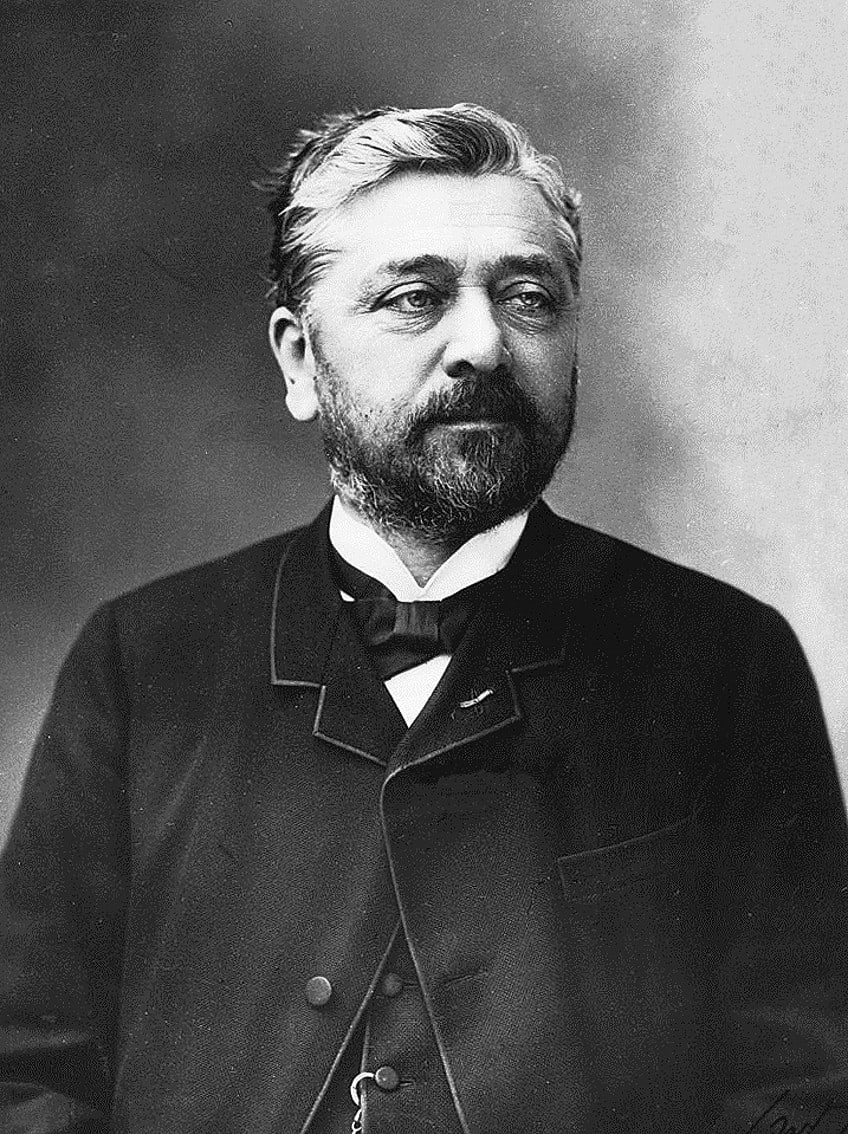
Lustig chose to concentrate on Poisson after the dealers emailed him their proposals since he had the most interest in owning the monument. Lustig arranged a private meeting with Poisson and persuaded him that he was a corrupt politician, arguing that his government job did not provide him with significant pay for the lifestyle he desired. Poisson agreed to pay a substantial bribe to gain ownership of the Eiffel Tower, believing that doing so would earn him a place among the top businesses. Yet, once Lustig collected his bribe and the cash for the “selling” of the monument, he escaped to Austria. Lustig felt that if Poisson discovered he had been duped, he would be too embarrassed and ashamed to contact the French authorities, but despite this assumption, he kept a close eye on newspapers while in Austria.
His suspicions were confirmed when he discovered no mention of his fraud in their pages, and he planned to go back to Paris later that year to pull out the scheme once more. But, when Lustig attempted to defraud another set of sellers and found a mark eager to buy the Eiffel Tower among them, the authorities were told about the scheme and he fled to the United States to avoid imprisonment.
Interesting Occurrences at the Eiffel Tower in Paris
Many interesting things occurred at the Eiffel Tower in the early 20th century. In 1910, Father Theodor Wulf recorded radiant energy at the tower’s summit and bottom. He discovered more than he expected at the top, accidentally uncovering what is now recognized as cosmic rays. On the 4th of February, 1912, Franz Reichelt, an Austrian tailor, died after leaping from the first floor of the tower to showcase his parachute design. A radio transmitter on the structure interfered with the German’s radio transmissions when World War I started in 1914, significantly hampering their attack on Paris and helping the Allies win that battle.

From 1925 until 1934, three of the tower’s sides were covered with lit signs for Citroen, making it the highest advertising area in the world at the time. In April 1935, it was used to test low-resolution television transmissions with a 200-watt shortwave transmitter. On the 17th of November, a new 180-line transmitter was deployed. The elevator cables were severed during the German takeover of Paris in 1940. During the occupation, the Eiffel Tower in Paris was closed to the general public, and the lifts were not restored until 1946.
That completes our look at the Eiffel Tower facts and history. The Eiffel Tower was the centerpiece of the Paris Exposition fair in 1889. It was originally erected to commemorate the centenary of the French Revolution, and to show the world France’s economic power. Although it was first regarded as the ugliest structure in Paris, it quickly became a symbol of the city.
Frequently Asked Questions
Who Built the Eiffel Tower?
Gustave Eiffel, the primary engineer in charge of the project, planned and constructed the Eiffel Tower. Many laborers and engineers were needed for the construction, and multiple subcontractors were engaged in the building of the tower’s various sections. During the design process, a team of scientists and mathematicians was also engaged to assure the tower’s safety and stability.
Exactly How Many People Died Building the Eiffel Tower, If Any?
It is said that just one worker perished as a consequence of an accident during the development of the Eiffel Tower, which took place over two years. Given the complexity and sheer magnitude of the project, this is considered a comparatively low number of casualties. The fatality rate was reduced to a bare minimum because of Eiffel’s stringent safety laws and practices. He commanded that all employees wear safety harnesses, and that construction be halted anytime there were severe winds.
Why Was the Eiffel Tower Built?
The Eiffel Tower was constructed as the entrance arch to the 1889 World’s Fair in Paris to commemorate the French Revolution’s 100th anniversary. The exposition was designed to display late-19th-century technological advances, and the Eiffel Tower was supposed to represent France’s economic superiority to the rest of the globe. The tower was also meant to have scientific relevance; it was to serve as a massive observatory, as well as a venue for meteorological and telecommunications research.
How Many Floors Is the Eiffel Tower and What Is the Eiffel Tower’s Height?
The entire height of the Eiffel Tower is about 324 meters. When it was finished in 1889, it was the tallest structure made by man in the world. The public is allowed access to three of the Eiffel Tower’s floors. The first and second floors are accessible through elevators or steps, respectively, while the third level is only accessible by stairs or a lift for those with limited mobility.
Justin van Huyssteen is a freelance writer, novelist, and academic originally from Cape Town, South Africa. At present, he has a bachelor’s degree in English and literary theory and an honor’s degree in literary theory. He is currently working towards his master’s degree in literary theory with a focus on animal studies, critical theory, and semiotics within literature. As a novelist and freelancer, he often writes under the pen name L.C. Lupus.
Justin’s preferred literary movements include modern and postmodern literature with literary fiction and genre fiction like sci-fi, post-apocalyptic, and horror being of particular interest. His academia extends to his interest in prose and narratology. He enjoys analyzing a variety of mediums through a literary lens, such as graphic novels, film, and video games.
Justin is working for artincontext.org as an author and content writer since 2022. He is responsible for all blog posts about architecture, literature and poetry.
Learn more about Justin van Huyssteen and the Art in Context Team.
Cite this Article
Justin, van Huyssteen, “Eiffel Tower in Paris – Why Was the Eiffel Tower Built?.” Art in Context. June 1, 2023. URL: https://artincontext.org/eiffel-tower-in-paris/
van Huyssteen, J. (2023, 1 June). Eiffel Tower in Paris – Why Was the Eiffel Tower Built?. Art in Context. https://artincontext.org/eiffel-tower-in-paris/
van Huyssteen, Justin. “Eiffel Tower in Paris – Why Was the Eiffel Tower Built?.” Art in Context, June 1, 2023. https://artincontext.org/eiffel-tower-in-paris/.





